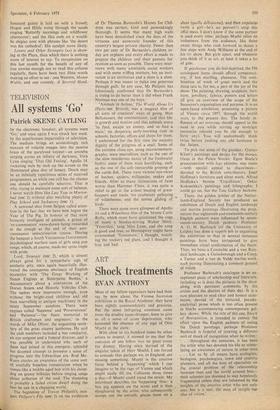ART
Shock treatments
EVAN ANTHONY
Most of my fellow appraisers have had their say by now about the Vienna Secession exhibition at the Royal Academy; they have been rightly commendatory and gracious. But the most intriguing comment came from the erudite name-dropper, keen to give us all a sense of acute deprivation, who lamented the absence of any sign of Otto Muchl in the show.
With close to six hundred items by other artists to inspect, it seemed to me that the omission of one fellow was no great cause for dismay. Having since learned of the singular talent of Herr Muehl, I am forced to concede that perhaps we, in England, are' missing something. Muehl is the creative force behind a 'happening' which 1 can imagine to be the rage of Vienna and which might easily fill the Coliseum three times a day—if Muehl could stand the strain. My informant describes the 'happening' thus: a live pig appears on the scene and is then slaughtered by the artist, who subsequently scoops out the entrails, places them on a sheet (quelle delicatesse), and then copulates (with a girl—he's no pervert!) atop this
offal mess. I don't know if the same partner is used every time; perhaps Muehl relies on volunteers from the audience, like those sweet things who rush forward to dance a few steps with Andy Williams at the end of
his TV show. But girls apart, and whatever you think of it as art, at least it takes a lot of guts.
If perchance you do feel deprived, the 598 catalogued items should afford compensat- ory, if less startling, pleasures. The com- bination of work of great merit and the third rate is, for me, a part of the joy of the show. The painting, drawing, sculpture, furn- iture, jewellery, fabrics, posters and letters all give an overview of the scope of the Secession's organisation and purpose. It is an open-faced exhibition, presenting a picture
of Vienna circa 1897, through the world wars, to the present day. The heady in- fluence of art nouveau should appeal to the
mod in you while stirring up nostalgic memories (should you be old enough to have any). You will undoubtedly think twice' before junking any old furniture in the future.
To pick out some of the goodies: Gustav Klimt's paintings and design for the mosaic frieze in the Palais Stoclet; Egon Shiele's
preoccupation with legs akimbo; one room —with special appeal to chauvinists—
devoted to the British contributors; Josef Hoffman's furniture and silver work; Alfred Hrdlicka's -bronze 'Crucifixion% Oskar Kokoschka's paintings and lithographs; I could go on, but the Tate Gallery beckons. There, the golden jubilee of the Nether- lands-England Society has produced an exhibition of Dutch and English landscape and marine paintings illustrating the prop- osition that eighteenth and nineteenth-century English painters were influenced by seven- teenth-century Dutch painters. Professor A. G. H. Bachrach (of the University of Leiden) has done a superb job in organising the exhibition so that in several instances paintings have been juxtaposed to give immediate visual confirmation of the thesis.
Thus, we have a Constable and a van Ruis- dael landscape, a Gainsborough and a Cuyp.
a Turner and a van de Velde marine work, each pairing illuminating a common ground of vision.
Professor Bachrach's catalogue is an ex- ceptional piece of scholarship and literature,
including as it does the pictures in the show alohg with pertinent comments by the artists and the diarists of their day. It is a
rare pleasure to read clear and honest state- ments, devoid of the tortured, pseudo- analytical prose which is too often present in blurbs accompanying contemporary gal- lery shows. While the title of this one, Shock of Recognition, is intended to convey the effect upon the English painters of seeing the Dutch paintings, perhaps Professor Bachrach is hopeful of creating a different sort of shock of recognition when he writes:
. . throughout the centuries, it has been the artist who has devoted his life to stimu- lating an awareness,of nature in other men . . . Let us by all means have ecologists, biologists, psychologists, town and country planners, and all the host of specialists on the crucial problem of the relationship between man and the world around him— their schemes are doomed to stay hopelessly fragmented unless they are informed by the insights of the creative artist who not only secs. but is a seer, the man of insight but also of vision.'


































 Previous page
Previous page